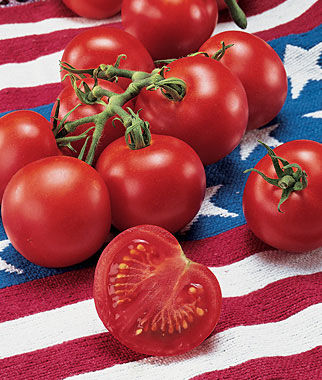Fourth of July Tomato (Independence Day Tomato)
Since 2010, Tomato Dirt has garnered 4.8+ million views, making it the web’s leading online source for growing tomatoes in the home garden. Award-winning writer and Tomato Dirt owner Kathy Widenhouse has helped thousands of home gardeners grow healthier tomatoes. Be one of them when you get Tomato Dirt’s Growing Guide here.
The Fourth of July tomato, sometimes called ‘Independence Day Tomato,’ is one of the earliest varieties of non-cherry tomatoes. Early season tomatoes mature in 65 days or less from the time plants are set out in the garden.
It is so named because it can produce ripe fruit by July 4 (Independence Day in the USA) in the typical climate. Even in regions with the shortest growing seasons, the plant has been known to yield red tomatoes by early July.
Fourth of July was bred by Burpee, which maintains exclusive distribution rights. As with other hybrids, the variety’s parentage remains a well-guarded industry secret.
The fruit’s main attractions are its early arrival, its dependability, disease resistance, and the sheer volume of fruit it produces. Even for an early tomato, critics agree, Fourth of July has a better-than-average taste. The only drawbacks mentioned regularly about this tomato are thicker-than-normal skin and occasional cracking.
What You Need to Know about Growing Fourth of July Tomato
How to Get True-to-Name Results
The Fourth of July tomato ripens 49 days after being set out in the garden. Plant seedlings by May 15 – certainly no later than Memorial Day, the last Monday in May – in order to pick ripened fruit by early July. Take precautions in areas that still have chilly overnight temperatures by using row covers or Wall-O-Water covers at night.
Good Things Come in Small Packages
Fruit is small, averaging about an inch or inch and a half in diameter and ranging in size between a golf ball and a tennis ball. As a salad tomato it is the perfect size.
The variety has particularly good flavor for an early tomato, and flavor improves in fruit as the season warms up. Unlike many early varieties, Fourth of July has won kudos for taste. In the 2004 Tomato Tasting Reports (University of California at Davis), Fourth of July got more votes than any other tomato, large or small, and won first place in the Salad & Slicing category.
Plants Produce Lots of Fruit
While gardeners readily admit that the fruit from this variety is small, the plants make up for size with the quantity of the harvest. Fourth of July is prolific. It continues to produce until early fall and in ideal conditions, up to first frost. In the words of one gardener: “Tomatoes from this plant come early, come often, and come until frost.”
Adaptable in Many Climates
Fourth of July also has widespread appeal across geographical regions.
- Short season gardeners like it because they can harvest fruit sooner than later.
- Long season gardeners find that the variety has a second and even third harvest once evening temperatures are low enough for fruit to set.
- Hot climate gardeners cut back Fourth of July in the heat of the summer and look for a second wave of blossoms and fruit well into the fall. Some even start the Fourth of July indoors in June and plant in late July or early August to get fruit into November.
- High altitude gardeners normally struggle to get tomatoes to ripen, but the Fourth of July’s short maturity time makes the variety a favorite in those altitudes.
| Fourth of July Tomato (Independence Day Tomato) |
|---|
| Indeterminate |
| Type: hybrid |
| Origin: USA, Burpee, Inc. |
| Days to maturity: 49 days |
| Season: Early |
| Foliage/habit: Regular leaf |
| Fruit color: bright red |
| Fruit shape/size: globe, 2-4 ounces |
| Resistance: VFNT |
| Yield: prolific |
| Taste: good; tends to be more acidic than sweet |
| Other notes: skin tends to be thick |
Tomato Disease Resistance Codes
V Verticillium Wilt
F Fusarium Wilt
FF Fusarium, races 1 and 2
FFF Fusarium, races 1, 2, and 3
N Nematodes
A Alternaria
T Tobacco Mosaic Virus
St Stemphylium (Gray Leaf Spot)
TSWV Tomato Spotted Wilt Virus
More Tomatoes of the Month
Tomato of the Month: Fun and interesting tomatoes ...
Amish Paste Tomato ...
Anna Russian Tomato ...
Better Boy Tomato ...
Brandywine Tomato ...
Celebrity Tomatoes ...
Early Girl Tomato ...
Green Zebra Tomato ...
Jet Star Tomato: prolific, disease-resistant, low-acid ...
Mortgage Lifter Tomato ...
Purple Haze Tomato ...
San Marzano Tomatoes ...
Sweet 100 Tomato ...
Yellow Pear Tomato ...
See more tomato varieties on our Pinterest board ...
Return from Fourth of July Tomato to Tomato Dirt home
As an Amazon Associate and Rakuten Advertising affiliate I earn from qualifying purchases.
SHARE THIS PAGE:
FREE! 10 Must-Know Tomato Growing Tips: 20-page guide
Get yours here:





New! Comments
Have your say about what you just read! Leave a comment in the box below.